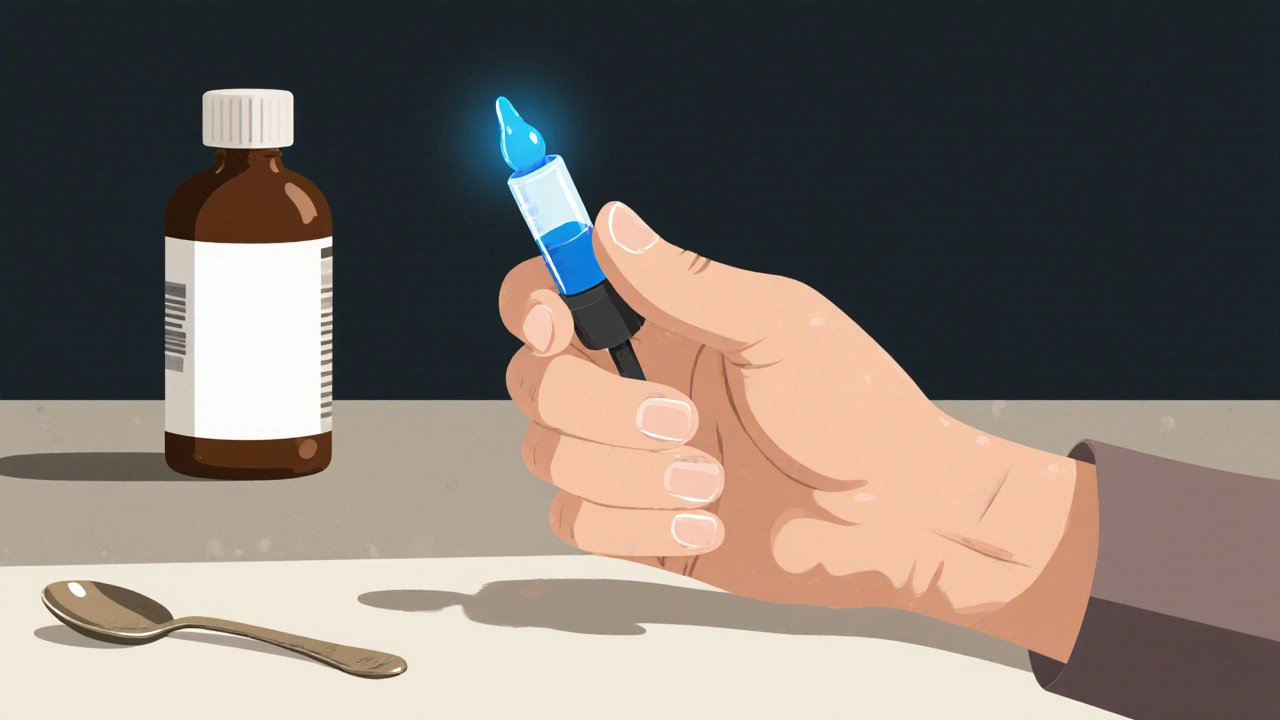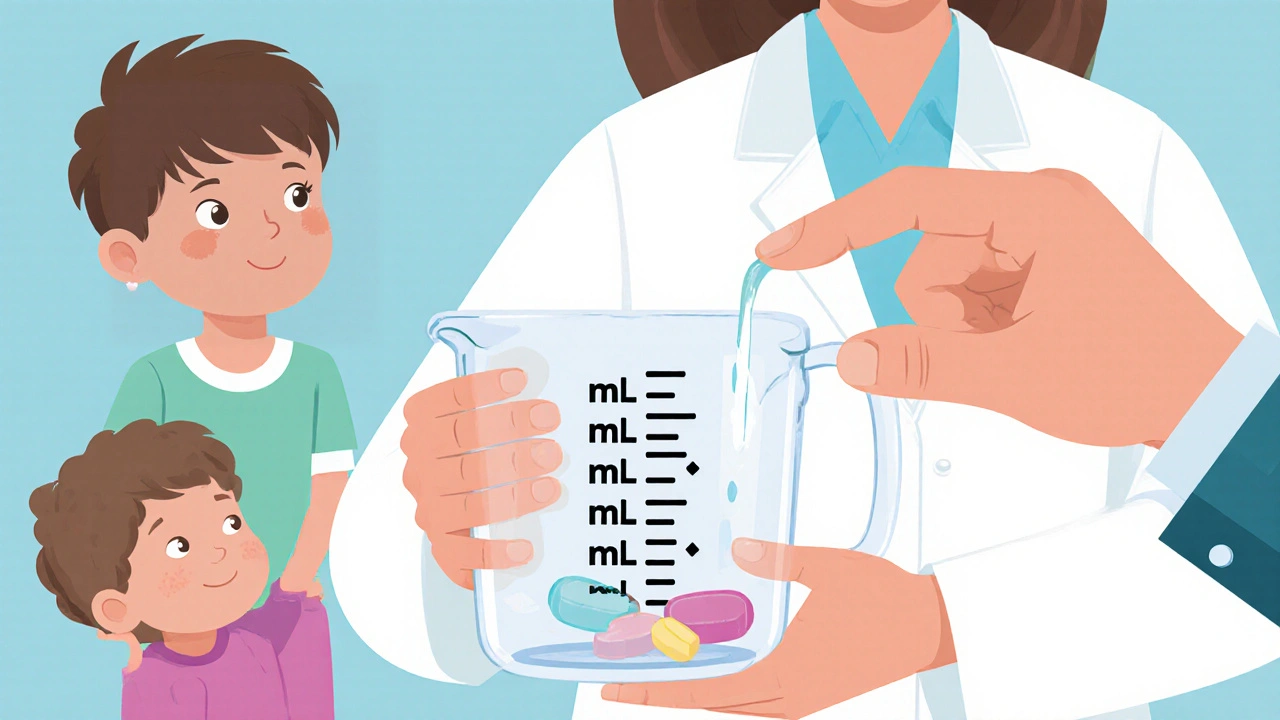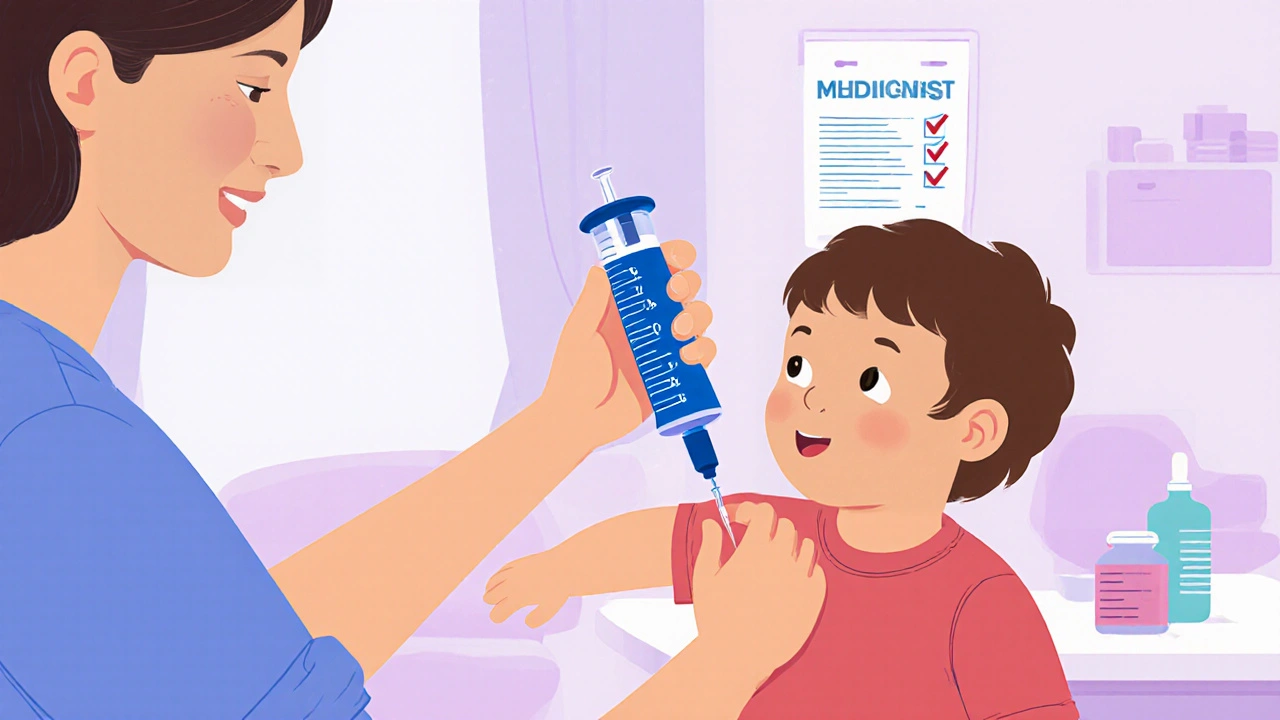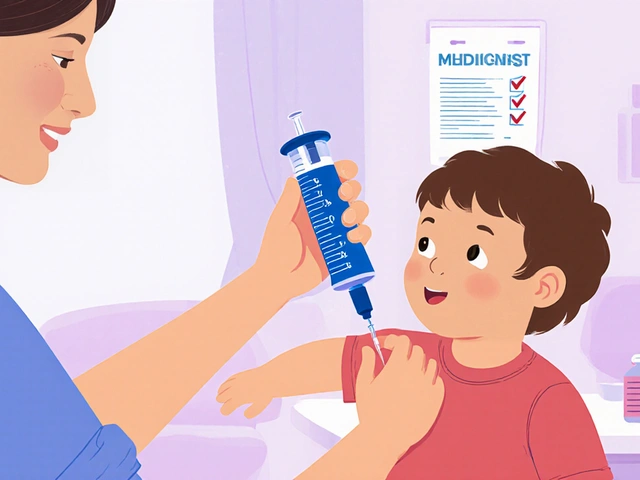Medication Unit Converter
Convert Medication Measurements
Accurately convert between milliliters (mL), teaspoons (tsp), and tablespoons (tbsp) for safe medication dosing.
Visual Dosing Guide
See what your dose looks like using proper measurement tools.
Important: Always use proper dosing tools (syringes, droppers, or measuring cups) - never kitchen spoons.
Conversion Results
Getting the right dose of medicine isn’t just about following the label. For kids, older adults, or anyone managing complex treatments, a tiny mistake - half a milliliter too much or too little - can mean the difference between healing and harm. That’s where visual dosing aids come in. These aren’t fancy gadgets. They’re simple tools: syringes with bold numbers, droppers with color-coded tips, cups with clear lines. But they work. A lot better than you might think.
Why Visual Dosing Aids Matter
Medication errors are one of the most common causes of preventable harm in healthcare. The Institute of Medicine estimates over 1.5 million such events happen every year in the U.S. alone. Many of these happen because people have to do math under pressure - calculating a child’s dose based on weight, guessing how much liquid to draw up, or confusing teaspoons with milliliters.
Visual dosing aids cut through that confusion. They remove the need to convert units, remember decimal points, or estimate. Instead, you see exactly where the medicine should stop. A 2018 study showed that in emergency situations - like reacting to a contrast dye - doctors using visual aids made 54.5% fewer dosing errors than those using standard tools. And they gave the medicine 36% faster.
This isn’t just for hospitals. Parents giving liquid antibiotics to a feverish toddler, caregivers helping an elderly relative take blood thinners, or even adults managing daily insulin doses all benefit. The goal isn’t to replace training - it’s to make training work better.
How Syringes Are Built for Accuracy
Not all oral syringes are the same. The ones designed for medication use have features regular syringes don’t.
- Bold, high-contrast markings: Instead of tiny lines, they have thick, dark lines at every 0.1 mL or 0.5 mL. Some even have numbers printed directly on the barrel.
- No needle: Oral syringes are blunt-tipped. This prevents accidental needle sticks and makes them safe for home use.
- Simplified scales: They don’t show every possible measurement. Only the ones you actually need. A syringe for a child’s liquid antibiotic might only show 1 mL, 2 mL, 3 mL - nothing beyond that.
- Color-coded barrels: Some have light backgrounds with dark lines, or dark barrels with bright white lines. This helps people with low vision or in dim lighting.
One study on pediatric antiretroviral therapy found that when caregivers used syringes with weight-based visual guides, dosing errors dropped dramatically. Kids were growing, their weight changed, and the syringe changed with them - no calculations needed. Just match the color band to the weight range, and draw up to the line.
Droppers That Tell You When You’ve Got It Right
Droppers are common for infants and small doses. But a standard glass dropper? It’s easy to squeeze too hard. Too many drops. Too little.
Modern visual dosing droppers fix that:
- Color-changing tips: Some droppers have a small window or tip that turns from clear to blue (or another color) when you’ve drawn the correct dose. No guessing.
- Fixed-volume designs: Some droppers only hold one exact dose - say, 1.25 mL. You fill it once. You can’t overfill it. You can’t underfill it.
- Anti-drip features: The tip is shaped to stop drips after you stop squeezing. That means less waste and less mess on the baby’s face.
These aren’t just for babies. Older adults with shaky hands or arthritis also benefit. One caregiver in New Zealand told me she switched from a teaspoon to a color-changing dropper for her husband’s blood pressure medicine. "I used to panic I’d give too much," she said. "Now I just watch the color change. I know it’s right."
Measuring Cups and Oral Dosing Devices
For larger doses - like 5 mL or 10 mL - measuring cups are still widely used. But here’s the catch: a kitchen teaspoon holds about 5 mL, but not reliably. A tablespoon? That’s 15 mL - three times too much for many kids’ doses.
Visual dosing cups are different:
- Clear, raised lines: Not printed on the side, but molded into the plastic so they don’t wear off.
- Multiple unit markings: mL, teaspoons, tablespoons - all shown clearly, but with mL as the primary unit.
- Non-slip bases: So they don’t tip over when you’re holding a fussy child.
- Spout design: Some have a narrow spout to control flow, reducing spills.
These cups are especially important for people managing chronic conditions like epilepsy or heart failure, where even a 1 mL error can trigger side effects.

What the Research Shows
A 2018 simulation study with 138 radiology staff tested epinephrine administration during a simulated allergic reaction. Half used standard tools. Half used visual dosing posters and syringes.
- Groups with visual aids made only 18.2% dosing errors. Groups without? 40%.
- Time to give the medicine dropped from 152 seconds to 97 seconds.
- 97.8% of participants said they’d use the visual aid again.
- 87% said it would help them give medicine faster in a real emergency.
Even with these tools, errors didn’t disappear. The most common mistake? Self-administering the injection incorrectly. That tells us something important: tools help, but they’re not magic. Training, clear protocols, and double-checking still matter.
Common Mistakes People Make - Even With Visual Aids
People assume visual aids eliminate all errors. They don’t. Here’s what still goes wrong:
- Confusing mL with teaspoons: Even with a marked syringe, some still reach for a kitchen spoon because it’s "familiar." Never use a kitchen spoon.
- Not holding the syringe level: If you tilt it, the liquid doesn’t sit flat. You read the line wrong. Always hold it at eye level.
- Ignoring expiration or damage: A cracked syringe or faded markings? Toss it. Don’t risk it.
- Not checking the prescription: Visual aids show you how to measure - not what to measure. Always confirm the dose with the label or pharmacist.
One nurse in a Wellington clinic told me she caught a parent giving a child twice the dose because they used the wrong syringe - one meant for a different medicine. "The lines looked similar," she said. "We now label each syringe with the medicine name. Simple, but it works."
How to Choose the Right Tool
Not every tool works for every situation. Here’s how to pick:
- For infants under 1 year: Use a color-changing dropper or a 1 mL oral syringe. Precision matters most.
- For toddlers and young children: Use a 5 mL or 10 mL oral syringe with bold markings. Avoid cups unless you’re sure they won’t spill.
- For older adults: Look for large-print syringes or cups with non-slip grips. If they have shaky hands, a dropper with a fixed dose may be safest.
- For chronic conditions: Use syringes or cups that match the exact dose prescribed. If it’s always 7.5 mL, get one marked for that.
- For travel: Pack pre-filled syringes or single-dose droppers. Avoid bulk bottles unless you have a reliable measuring tool.
Always ask your pharmacist for the right tool. Most pharmacies now stock visual dosing syringes for free or at low cost. Don’t assume the one that came with the medicine is the best one.

What’s Next for Visual Dosing Aids
These tools are getting smarter. Some new syringes now have QR codes that link to video instructions. Others connect to apps that track doses. But the core idea hasn’t changed: reduce mental load, increase confidence, prevent mistakes.
Health systems are starting to standardize them. The Joint Commission and the Institute for Safe Medication Practices both recommend visual aids as part of safety protocols. In New Zealand, hospitals are phasing out kitchen spoons entirely for medication dosing.
It’s not about technology. It’s about making safety obvious.
Frequently Asked Questions
Can I use a kitchen teaspoon to measure medicine?
No. A kitchen teaspoon holds anywhere from 3 to 7 mL - it’s not accurate. Always use a proper oral syringe, dropper, or measuring cup designed for medicine. Even a slight difference can be dangerous, especially for children or seniors.
Are visual dosing aids only for kids?
No. While they’re especially helpful for children, older adults, people with vision problems, or those managing multiple medications also benefit. Anyone who needs to measure small, critical doses - like blood thinners or thyroid meds - should use them.
Do I need training to use visual dosing aids?
Most don’t require formal training. Good visual aids are designed to be intuitive. But it helps to watch a pharmacist demonstrate once. Make sure you understand how to read the lines, hold the tool level, and check the dose against the prescription.
What if the markings on my syringe fade?
Replace it immediately. Faded lines are dangerous. Don’t try to guess. Most pharmacies will give you a new one at no cost. Always check the condition of your dosing tool before each use.
Can visual dosing aids prevent all medication errors?
No. They reduce errors significantly - by over half in some cases - but they’re not foolproof. Always double-check the dose against the prescription. Never rely on one tool alone. Combine visual aids with clear labeling, pharmacist advice, and a second set of eyes when possible.
Final Thoughts
Medication safety isn’t about being perfect. It’s about building layers of protection. Visual dosing aids are one of the strongest, simplest layers we have. They don’t need electricity. They don’t need Wi-Fi. They just need to be used correctly.
If you’re giving medicine to someone you care about - a child, a parent, a partner - ask for a visual dosing tool. Don’t wait for a mistake to happen. Make the safe choice now. It’s not about being careful. It’s about making care easy.



Joseph Peel
November 17, 2025 AT 12:33Visual dosing aids are a no-brainer. The data is clear: fewer errors, faster administration, better outcomes. Why are we still using kitchen spoons in 2025? This isn’t innovation-it’s basic hygiene in healthcare.
Kathryn Ware
November 18, 2025 AT 03:54I’ve been using the color-changing droppers for my mom’s blood pressure meds since last year. She has tremors from Parkinson’s and used to spill half the dose every time. Now she just watches the tip turn blue and smiles like she just won the lottery. I wish every pharmacy handed these out for free. Also, the non-slip cups? Game changer. No more medicine on the floor or the cat’s tongue.
Kelsey Robertson
November 19, 2025 AT 03:58Joseph Townsend
November 19, 2025 AT 06:25Let me tell you, I used to be the guy who eyeballed my kid’s antibiotics with a teaspoon. Then one night, he turned purple. Not a joke. Turned purple. We rushed to the ER. Turned out I’d given him 2.5x the dose. That was the night I bought my first oral syringe. Now I have three. One for each kid. One for travel. One for emergencies. I don’t care if it’s ‘just liquid’-when it’s your kid’s life, you don’t gamble with milliliters. These tools aren’t fancy. They’re holy.
Bill Machi
November 21, 2025 AT 02:55Why are we letting untrained parents and caregivers handle complex dosing? This isn’t a DIY project. It’s a public health failure. We should be mandating nurse visits for every prescription involving liquids. Not giving people plastic syringes and calling it a day. This is just band-aiding a broken system. And don’t get me started on the ‘color-coded’ nonsense. What if someone’s colorblind? Who thought this was a good idea?
Elia DOnald Maluleke
November 22, 2025 AT 21:49In South Africa, we call this ‘the quiet revolution.’ No fanfare. No viral TikTok. Just grandmothers in Limpopo using droppers with blue tips to give ARVs to toddlers. No math. No panic. Just trust in the color. I’ve seen it. I’ve lived it. This isn’t American innovation. This is human ingenuity meeting necessity. And yes, the syringes are often donated. But the dignity? That’s ours.
satya pradeep
November 24, 2025 AT 20:53Bro this is so true. I work in a clinic in Bangalore and we give out these syringes free with every antibiotic script. Parents used to ask for spoons like it was normal. Now they bring their own syringes and ask if they got the right one. One lady even drew a diagram on her phone to show me how she used it last time. That’s progress. No hype. Just real life. Also, the anti-drip droppers? They don’t ruin baby’s shirts. Small win, big deal.
Prem Hungry
November 25, 2025 AT 09:50As someone who’s cared for my father with CHF for 7 years, I can say this: visual dosing tools saved his life. He was on 3 different liquids. Once, he confused the blood thinner with the diuretic. He didn’t mean to. His vision’s bad. The syringes had different colors and labels. We put them in a box with names written in big letters. He still forgets sometimes. But now, he says, ‘I see the line. I know it’s right.’ That’s not tech. That’s love made visible.
Leslie Douglas-Churchwell
November 25, 2025 AT 12:32Of course they’re pushing this. It’s part of the Great Medication Control Initiative. You think these syringes are just for safety? Think again. The QR codes? They’re tracking your dose patterns. The apps? They’re feeding data to insurers. And the ‘color-changing’ tips? That’s nanotech monitoring your compliance. They want you dependent on their tools so they can penalize you later if you miss a dose. This isn’t healthcare. It’s surveillance with a smiley face.
shubham seth
November 26, 2025 AT 19:45Let’s be real. These ‘visual aids’ are just a Band-Aid on a hemorrhage. The real problem is that doctors prescribe in mL but patients think in teaspoons. That’s not a tool failure-that’s a systemic failure of medical education. And don’t get me started on how pharmacies hand out syringes like candy but never explain how to hold them level. Half the people using these are tilting them like they’re pouring whiskey. This isn’t helping. It’s enabling ignorance.
kora ortiz
November 27, 2025 AT 06:14I love this so much. My niece had epilepsy and we were terrified of dosing wrong. We got the syringe with the bold 5mL line and the non-slip base. She’s 8 now and she holds it herself. She says, ‘I’m the medicine captain.’ That’s not just safety. That’s empowerment. We need more of this. Not just in hospitals. In every home. In every pharmacy. Make it normal. Make it easy. Make it beautiful.
Jeremy Hernandez
November 28, 2025 AT 11:31Tarryne Rolle
November 29, 2025 AT 07:31Is it just me, or is this whole movement a quiet surrender? We’ve accepted that people can’t do basic math, so we’ve designed medicine around their incompetence. We’re not elevating understanding-we’re lowering standards. What’s next? Medication with emojis? ‘Blue drop = good. Red drop = bad.’ We’re not solving the problem. We’re designing a world where the problem doesn’t have to be solved. That’s not progress. That’s resignation.
Sridhar Suvarna
December 1, 2025 AT 06:24When I was a med student in Mumbai, we used to measure liquids with a syringe we cleaned and reused. No markings. Just estimation. Now I see my cousin in Delhi using a color-coded dropper for her son’s fever meds. No panic. No math. Just trust in the blue. That’s the real win. Not the tech. Not the study. The dignity. The peace. That’s what this is for. We don’t need more rules. We need more clarity. And sometimes, that’s just a line on a tube.